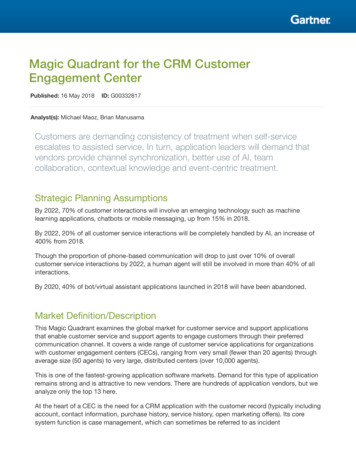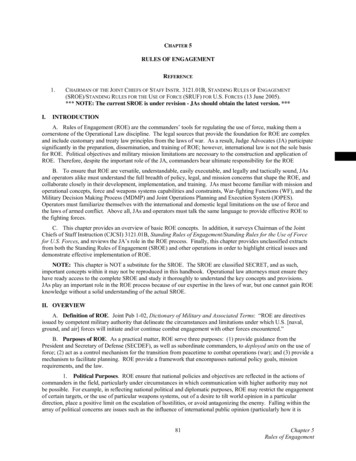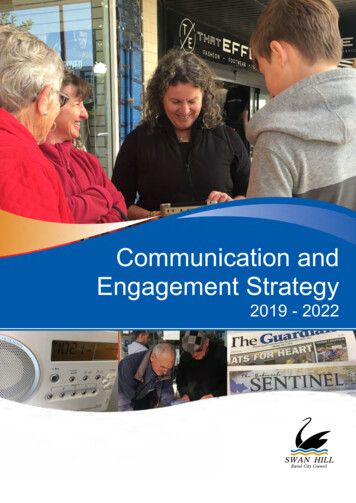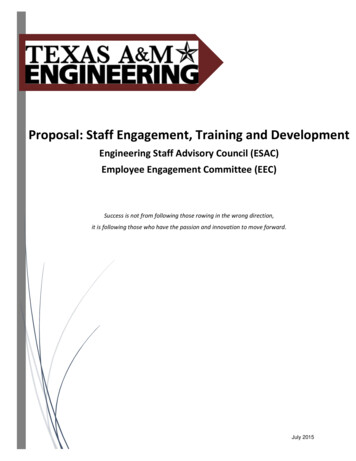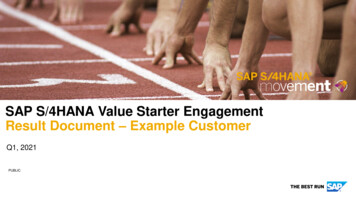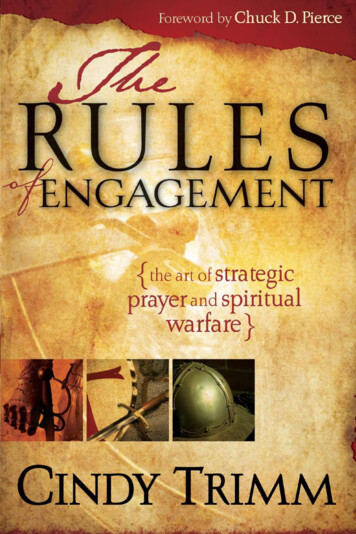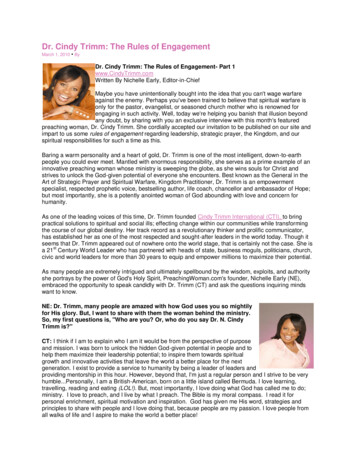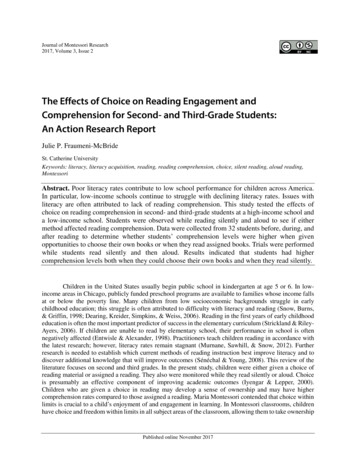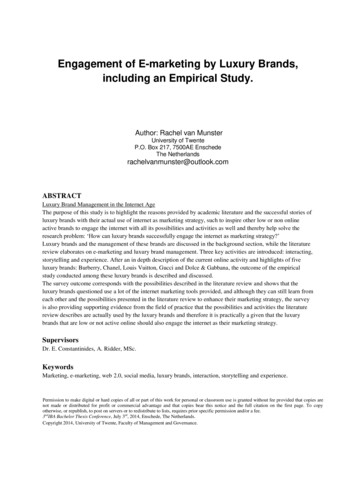
Transcription
Engagement of E-marketing by Luxury Brands,including an Empirical Study.Author: Rachel van MunsterUniversity of TwenteP.O. Box 217, 7500AE EnschedeThe ury Brand Management in the Internet AgeThe purpose of this study is to highlight the reasons provided by academic literature and the successful stories ofluxury brands with their actual use of internet as marketing strategy, such to inspire other low or non onlineactive brands to engage the internet with all its possibilities and activities as well and thereby help solve theresearch problem: ‘How can luxury brands successfully engage the internet as marketing strategy?’Luxury brands and the management of these brands are discussed in the background section, while the literaturereview elaborates on e-marketing and luxury brand management. Three key activities are introduced: interacting,storytelling and experience. After an in depth description of the current online activity and highlights of fiveluxury brands: Burberry, Chanel, Louis Vuitton, Gucci and Dolce & Gabbana, the outcome of the empiricalstudy conducted among these luxury brands is described and discussed.The survey outcome corresponds with the possibilities described in the literature review and shows that theluxury brands questioned use a lot of the internet marketing tools provided, and although they can still learn fromeach other and the possibilities presented in the literature review to enhance their marketing strategy, the surveyis also providing supporting evidence from the field of practice that the possibilities and activities the literaturereview describes are actually used by the luxury brands and therefore it is practically a given that the luxurybrands that are low or not active online should also engage the internet as their marketing strategy.SupervisorsDr. E. Constantinides, A. Ridder, MSc.KeywordsMarketing, e-marketing, web 2.0, social media, luxury brands, interaction, storytelling and experience.Permission to make digital or hard copies of all or part of this work for personal or classroom use is granted without fee provided that copies arenot made or distributed for profit or commercial advantage and that copies bear this notice and the full citation on the first page. To copyotherwise, or republish, to post on servers or to redistribute to lists, requires prior specific permission and/or a fee.3ndIBA Bachelor Thesis Conference, July 3rd, 2014, Enschede, The Netherlands.Copyright 2014, University of Twente, Faculty of Management and Governance.
1. INTRODUCTIONFor a couple of years already it is obvious that we live inthe digital area. The internet and social media has becomean extensive part of people s everyday life which offersgreat opportunities for any company in any industry tointeract with their customers and to enhance theirmarketing strategy. Unfortunately the internet is not usedto the fullest by these businesses yet. They do not takefull advantage of the possibilities and activities thatinternet marketing offers. This could be because of thefact that internet marketing and social media is stillfrequently seen as particularly new, or since thesebusinesses do not know of successful examples ‘outthere’.Brands, and especially luxury brands seem to have a goodunderstanding, for many years already, of how to selltheir brand and image together with a fully equippedexperience to the customer. In particular the top luxurybrands seem to have exploited e-marketing to their ownadvantage. Including interacting with the consumers andtelling the original story of the brand, these brands areable to create an entire online experience with the toolsprovided by the internet and new technologies. Thesuccessful engagement of internet as the luxury brands’marketing strategy leads to fascinating examples, inspiredby the successful stories of the luxury brands.In the literature review the ideal situation of theengagement of e-marketing by brands is sketched - byuse of academic literature, and three key activities areintroduced: interacting, storytelling and experience.Examples are given of luxury brands with some of thehighest online activity and social media followers:Burberry, Chanel, Louis Vuitton, Gucci and Dolce &Gabbana, including their current e-marketing strategy andonline presence. The empirical study is conducted by asurvey among the marketing managers of the previouslymentioned brands, and tests if the luxury brands approachcorresponds with the expectations written in the literaturereview and the brand online activity. And if there are anyrecommendations or improvements for these luxurybrands when in the outcome of the survey the brands arecompared to each other and to the endless array of emarketing possibilities to improve the interaction,storytelling and experience.The purpose of this study is to highlight the reasonsprovided by academic literature and the successful storiesof luxury brands with their actual use of internet asmarketing strategy, such to inspire other brands to engagethe internet with all its possibilities and activities as well.1.1 Research ProblemThere is a gap between what is possible in terms of emarketing and how brands are currently using thesepossibilities. With the help of successful luxury brandsthis study tries to reduce this area of controversy and helpsolve the following research problem:How can luxury brands successfully engage the internetas their marketing strategy?To be able to address this problem this study elaborateson: Luxury Brands and their Management, Marketing, Emarketing, and finally Luxury Brand Management and Emarketing, where the various components andpossibilities of E-marketing are addressed. The onlineactivity and highlights of the luxury brands is describedand the actual use of these E-marketing tools is going tobe test in the survey. This research focusses specificallyon the top luxury brands based on the assumption thatthese brands use E-marketing in the most advancedmanner. Furthermore the research will address in how farE-marketing is of a strategic essence to the luxury brands.1.2 Justification of StudyVarious academic papers and researches address theimportance of internet in relation to marketing and morerecent papers highlight the use of social media. Mangold& Faulds state: ‘The tools and approaches forcommunicating with customers have changed greatlywith the emergence of the internet and social media;therefore, businesses must learn how to use the socialmedia in a way that is consistent with their business plan’(Mangold & Faulds, 2009) (Paquette, 2013)Yet engaging internet as their marketing strategy is notonly important for the business, ‘Interacting and shoppingacross channels is also exactly what the customers expectfrom brands. Previous research in the context of onlinefashion show that customers want a website experiencethat is engaging, memorable and interactive; a websitethat can offer social interaction, two-way communicationand a personalized relationship with the brand’ (Siddiquiet al. 2003, Lacroix and Riley, 2003 Serringhaus, 2005)(Hansen, 2007). ‘Moreover, the interactive andcollaborative aspects are also what industry reports fromMcKinsey and the Economist business surveys point outas opportunities for increasing a company s revenueand/or margins’ (McKinsey, How businesses are usingWeb 2.0: A McKinsey Global Survey, 2007) (McKinsey,Building the Web 2.0 Enterprise, 2008) (EconomistIntelligence Unit Research, 2007)According to Uché Okonkwo, writer of ‘Luxury Online’‘Luxury Fashion Branding’ and various reports, ‘thequestion of 'why' luxury should be online is no longerrelevant but the current issue is 'how' luxury shouldpresent itself online particularly as consumers take chargeof their virtual experiences. As the most powerfulmarketing tool that will drive luxury forward in the nextcentury, the internet has become indispensable for brandreinforcement, breaking into new territories, engagingclients and demonstrating overall value.’ (Okonkwo U. ,2010)‘Social media channels offer both firms and customersnew ways of engaging with each other. Companies hopeto engage with loyal customers and influence individuals’perceptions about their products, spread information, and1
learn from and about their audience’ (Brodie, Illic, Juric,& Hollebeek, 2013). Altogether ‘internet and socialmedia open up a whole new world for luxury brands byproviding an endless array of potential interactions withconsumers, which is the main reason why there is a needfor an increase in studies examining the impact of thenew phenomenon.’ (Paquette, 2013)1.3 Deficiencies in the EvidenceAlthough internet and social media marketing is a wellresearched topic, I see a gap in researches which describee-marketing in the field of practice and use multiplesuccessful luxury brands as example. There areresearches that focus on retail and general luxury, but thetop luxury brands are rarely researched, while theseleading brands provide hands on examples how to applythe theory in practice.1.4 Key ConceptsThe key terms are marketing, e-marketing, web 2.0,social media, luxury brands, interacting, storytelling andexperience.Digital marketing is also known as E-marketing whichconsists of web 1.0 (one way communication) and web2.0 (two way communication). Social media is seen asthe applications of web 2.0.1.5 AudienceThe audience effected are the top luxury brands Burberry,Chanel, Louis Vuitton, Gucci and Dolce & Gabbana whoare leading examples for the non or low online activebrands and luxury brands who can benefit from thisstudy.1.6 PurposeThe purpose of this study is to highlight the reasonsprovided by academic literature and the successful storiesof luxury brands with their actual use of internet asmarketing strategy, such to inspire other low or nononline active brands to engage the internet with all itspossibilities and activities as well and thereby help solvethe research problem: ‘How can luxury brandssuccessfully engage the internet as marketing strategy?’1.7 FindingsThe literature review about e-marketing and luxury brandmanagement introduced three key activities: interacting,storytelling and experience. The survey outcomecorresponds with the possibilities described in theliterature review and shows that the luxury brandsquestioned use a lot of the internet marketing toolsprovided, and although they can still learn from eachother and the possibilities presented in the literaturereview to enhance their marketing strategy, the survey isalso providing supporting evidence from the field ofpractice that the possibilities and activities the literaturereview describes are actually used by the luxury brandsand therefore it is practically a given that the luxurybrands that are low or not active online should alsoengage the internet as their marketing strategy.1.8 MethodologyThe data collection technique for the secondary data is aliterature review of academic papers, books and reports.The primary data is a survey of marketing managers ofluxury brands. The following five luxury brands arechosen because of their high publicity, social mediaactivity and online presence: Burberry, Chanel, LouisVuitton, Gucci and Dolce & Gabbana.The survey consists of five questions made in and sendthrough Google Drive. The questions are included inAppendix 1. Marketing managers and (global) socialmedia managers of Burberry, Chanel, Louis Vuitton,Gucci and Dolce & Gabbana were contacted. All thesemanagers completed the survey, except for Burberry. Ihave been in contact with four social media marketingmanagers at Burberry who all responded with the sameanswer: Burberry has a strict policy not to share anycompany information about their marketing strategyexternal. They can’t speak on behalf of the brand orcontribute to Thesis or Dissertation projects.1.9 BackgroundBrandsBefore we dive into luxury brands and the luxury world,it is important to first define brands because ‘there is noluxury without brands’ says former LVMH top manVincent Bastien. (Bastien & Kapferer, 2013). TheAmerica Marketing Association (AMA) defines a brandas “a name, term, design, symbol or any other feature thatidentifies one seller's good or service as distinct fromthose of other sellers.” But a brand is not only adistinction. According to Idris Mootee a brand is ‘anintangible asset that resides in people’s hearts and minds.It’s defined by the expectations people have abouttangible and intangible benefits that are developed overtime by communications and, more importantly, by theactions of the brand.’ (Mootee, 2013) Brands focus onidentity- and customer-orientation, which means thatcompanies use brands to identify their products orservices, and make deep impressions on customer minds.(Heine, 2012) (Zhang, 2013) Therefore ‘branding is alsodescribed as the art and science of identifying andfulfilling human physical and emotional needs bycapturing attention, imagination and emotion longenough to make money from it.’ (Mootee, 2013)Luxury brandsLuxury brands are one of the purest examples of brandingand a dominant phenomenon in today’s marketplace. Thenumber of luxury consumers worldwide has more thantripled over the past 20 years, from roughly 90 millionconsumers in 1995 to 330 million at the end of 2013,according to an extensive study of 10,000 luxuryconsumers, conducted by Bain & Company. (D'Arpizio,2014) (Keller, 2009) They are defined by many authors2
and mostly characterized by a high level of price, quality,and exclusivity. Kapferer & Bastien give a verycomprehensive definition of a luxury brand in their book‘The Luxury Strategy’: ‘A luxury brand produces a veryqualitative hedonistic experience or product made to last,and offers this at a price that far exceeds what their merefunctional value would command. The luxury brand istied to a heritage, has unique know-how and a cultureattached to the brand. The products or services of aluxury brand are available in purposefully
marketing strategy, such to inspire other brands to engage the internet with all its possibilities and activities as well. 1.1 Research Problem There is a gap between what is possible in terms of e-marketing and how brands are currently using these possibilities. With the help of successful luxury brands

